

Laodicea. Seven Cities of Revelation: Laodicea. In 190 BC Laodicea came under the rule of Pergamum, then after 133 BC it was controlled by Rome and made a free city.
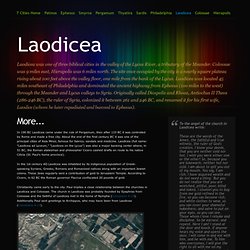
About the end of the first century BC it was one of the principal cities of Asia Minor, famous for fabrics, sandals and medicine. Laodicea (full name: "Laodicea ad Lyceum," "Laodicea on the Lycus") was also a major banking center where, in 51 BC, the Roman statesman and philosopher Cicero cashed drafts en route to his native Cilicia (St.
Paul's home province). In the 1st century AD Laodicea was inhabited by its indigenous population of Greek-speaking Syrians, Greeks, Romans and Romanized natives along with an important Jewish colony. These Jews regularly sent a contribution of gold to Jerusalem Temple. Christianity came early to the city. Laodicean Church - Religion-wiki. The Laodicean Church was a Christian community established in the ancient city of Laodicea (on the river Lycus, in the Roman province of Asia Minor).
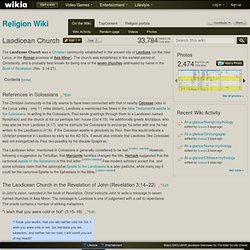
The church was established in the earliest period of Christianity, and is probably best known for being one of the seven churches addressed by name in the Book of Revelation (Rev. 3.14-21). References in Colossians. A IGREJA DE LAODICÉIA. A cidade de Laodicéia situava-se cerca de 80 km de Éfeso e 64km a sudeste de Filadélfia.

Era uma cidade muito rica, consistindo em centros de comércio e indústria muito prósperos na época. A cidade em si estava totalmente imersa na cultura grega. As ruínas de três igrejas encontradas na cidade evidenciaram que as mesmas eram realmente ricas, do ponto de vista financeiro. Pérgamo. Origem: Wikipédia, a enciclopédia livre.
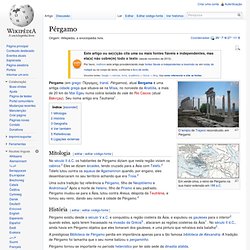
Pérgamo (em grego: Πέργαμος, transl. Pérgamos), atual Bergama é uma antiga cidade grega que situava-se na Mísia, no noroeste da Anatólia, a mais de 20 km do Mar Egeu numa colina isolada do vale do Rio Caicos (atual Bakırçay). Seu nome antigo era Teutrania1 . Em verde-oliva, o reino de Pérgamo na sua maior extensão em 188 a.C. Mitologia[editar | editar código-fonte] No século II d.C. os habitantes de Pérgamo diziam que nesta região viviam os cabiros.2 Eles se diziam árcades, tendo cruzado para a Ásia com Télefo.2 Télefo lutou contra os aqueus de Agamemnon quando, por engano, eles desembarcaram no seu território achando que era Troia.2 História[editar | editar código-fonte] Pergamon. Pergamon or Pergamum (Greek: Πέργαμος, modern day Bergama in Turkey, 39°7′N 27°11′E) was an ancient Greek city, in Mysia, northwestern Anatolia, 16 miles from the Aegean Sea, located on a promontory on the north side of the river Caicus (modern day Bakırçay), that became an important kingdom during the Hellenistic period, under the Attalid dynasty, 282-129 BC.
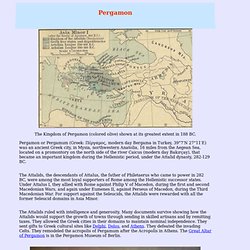
The Attalids, the descendants of Attalus, the father of Philetaerus who came to power in 282 BC, were among the most loyal supporters of Rome among the Hellenistic successor states. Bergama. Bergama is a populous district, as well as the center city of the same district, in İzmir Province in western Turkey.

By excluding İzmir's metropolitan area, it is one of the prominent districts of the province in terms of population and is largely urbanized at the rate of 53,6 per cent. Tire center is situated at a distance of 118 km (73 mi) to the north from the point of departure of the traditional center of İzmir (Konak Square in Konak, İzmir) and lies at a distance of 27 km (17 mi) inland from the nearest seacoast at the town of Dikili to its west. Bergama district area neighbors the areas of three districts of Balıkesir Province to its north, namely Ayvalık, Burhaniye and İvrindi, İzmir Province district of Kınık and Manisa Province district of Soma to its east, while to the south it is bordered by the central provincial of Manisa and two other İzmir Province districts along the coast that are Aliağa and Dikili from its south towards its west.
Name[edit] Pergamon Altar. The Pergamon Altar is a monumental construction built during the reign of King Eumenes II in the first half of the 2nd century BC on one of the terraces of the acropolis of the ancient city of Pergamon in Asia Minor.

In 1878, the German engineer Carl Humann began official excavations on the acropolis of Pergamon, an effort that lasted until 1886. The excavation was undertaken in order to rescue the altar friezes and expose the foundation of the edifice. Later, other ancient structures on the acropolis were brought to light. A IGREJA DE PÉRGAMO. A IGREJA DE PÉRGAMO - A IGREJA DO ESTADO (312 - 606 d.C) Apocalipse 2:12-17 A igreja de Pérgamo existiu realmente no século I, mas era contaminada com outros costumes não bíblicos, e representa a época em que a Igreja Cristã sofreu um processo de contaminação, entre 312 d.C. e 606 d.C.

Pérgamo era a capital da Ásia até o final do século I. Era uma cidade entreugue à adoração a vários ídolos gregos, com grande predominância na adoração a Baco (deus da diversão) e a Asclépios (deus da sanidade). Em vista disto, o governador romano local tinha grandes dificuldades em conduzir as inúmeras diferenças religiosas presentes na cidade. Pergamus, Or Pergamum. Pergamum - Kusadasi Guide - Historical Places. Another building constructed by Eumenes II is the Library of Pergamum.

It was the second of the three famous ancient libraries which contained two hundred thousand volumes and which were given to Cleopatra a century later as a wedding present by Mark Antony to be added to the ones in the library of Alexandria. The library is located north of the Athena Sanctuary. The Library of Pergamum was rich in sources but when the Egyptians prohibited the export of papyrus, Pergamum King ordered a new material to be found which can take the place of papyrus.
What they found was called parchment which was a material made of sheep or goat skin. It was polished first with pumice stone and then slit into sheets. In the 2nd century Hadrian who was the successor of Trojan have the Temple of Trojan built in Pergamum in Corinthian order and dedicated it to Trojan itself. Healing temple. A Healing temple is a religious temple devoted towards Faith healing.
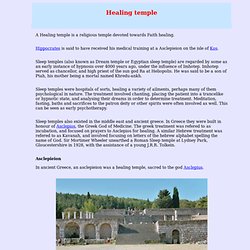
Hippocrates is said to have received his medical training at a Asclepieion on the isle of Kos. Sleep temples (also known as Dream temple or Egyptian sleep temple) are regarded by some as an early instance of hypnosis over 4000 years ago, under the influence of Imhotep. Imhotep served as chancellor, and high priest of the sun god Ra at Heliopolis. A Carta à Igreja em Pérgamo. A Carta à Igreja em Pérgamo A igreja em Pérgamo se encontrou numa situação difícil.
Por todos os lados, os vizinhos praticavam idolatria e deram honra aos governantes romanos. Sárdis. Origem: Wikipédia, a enciclopédia livre. O ginásio de Sardes (foto de 1º de fevereiro de 2003) Localizava-se no fértil vale do rio Hermo e no sopé do íngreme monte Tmolo, distante cerca de 34 km ao sul daquele curso d'água. A importância da cidade era devida ao seu poderio militar, à sua relevante localização ligando o Egeu ao interior e a situar-se em um vale muito fértil. O Reino da Lídia. O antigo reino da Lídia emergiu no início do seculo XIII a.C. como um reino “Neo-Hitita”, após o colapso do Império Hitita no século XII a.C. Melito of Sardis. Melito of Sardis (Greek: Μελίτων Σάρδεων Melíton Sárdeon) (died c. 180) was the bishop of Sardis near Smyrna in western Anatolia, and a great authority in Early Christianity: Jerome, speaking of the Old Testament canon established by Melito, quotes Tertullian to the effect that he was esteemed as a prophet by many of the faithful.
His feast is celebrated on April 1. Peri Pascha[edit] The "Dead" Church of Sardis. Out of all the churches mentioned in Revelation, I think (for me personally) that Sardis is perhaps the saddest story. Apocalipse - Estudo 3. Afrodisias. Sardis. Cartas às Igrejas - SARDES. Smyrna. The Leading Open Sad or Site on the Net. Mirra. Origem: Wikipédia, a enciclopédia livre. Mirra (árvore) THE CHURCH AT SMYRNA. THE CHURCH AT SMYRNA (Google Video--Highest Quality) We now begin the study of the church at Smyrna. Revelation 2:8-11 says: "And unto the angel of the church in Smyrna write; These things saith the first and the last, which was dead, and is alive; I know thy works, and tribulation, and poverty, (but thou art rich) and I know the blasphemy of them which say they are Jews, and are not, but are the synagogue of Satan. Éfeso - Enciclopédia Encydia-Wikilingue, a partir de éfeso wikipedia.
Éfeso - Wikilingue - Encydia Éfeso (grego Ephesos Έφεσος, turco: Efes, latín Ephesus) foi na antigüedad uma localidade da Ásia Menor, na actual Turquia. Foi uma das doze cidades jónicas a orlas do mar Egeo, situada entre o extremo norte de Panayr Dáğ (o antigo monte Pion) e a desembocadura do rio Caístro e tinha um porto chamado Panormo. Ao este se achavam a colina de Ayasoluk, com o vale a seus pés, e a população actual de Selçuk , cerca do mar, o monte Pion e o monte Coreso (actual Bulbul Dagh), a cujos pés se encontrava a cidade antiga.
Foi um importante centro religioso, cultural e comercial. Actualmente suas ruínas constituem uma atração turística importante. Fotografias dos Locais das Escrituras: Éfeso. As ruínas do teatro grego de Éfeso, onde o Apóstolo Paulo pregou. Na época do Novo Testamento, Éfeso ficou famosa em todo o mundo conhecido devido ao magnífico templo construído em honra a Diana, deusa pagã romana. Hoje em ruínas, Éfeso foi, certa vez, a capital da província romana da Ásia e um grande centro comercial. Os ourives de prata da cidade desenvolveram um negócio lucrativo vendendo imagens de Diana. Eventos importantes: O Apóstolo Paulo visitou Éfeso quase que ao final de sua segunda viagem missionária (Atos 18:18–19). Turkey and the Seven Churches of Revelation.
Seven churches, the first three. Apostasy began early, Rev. 2. First of the Seven ChurchesRevelation 2:1-13r02a 0201Charting the messages to the churches (v1) "Unto the angel of the church of Ephesus write; These things saith he that holdeth the seven stars in his right hand, who walketh in the midst of the seven golden candlesticks; (2) I know thy works, and thy labour, and thy patience, and how thou canst not bear them which are evil: and thou hast tried them which say they are apostles, and are not, and hast found them liars: (3) And hast borne, and hast patience, and for my name's sake hast laboured, and hast not fainted. (4) "Nevertheless I have somewhat against thee, because thou hast left thy first love. (5) Remember therefore from whence thou art fallen, and repent, and do the first works; or else I will come unto thee quickly, and will remove thy candlestick out of his place, except thou repent. (6) But this thou hast, that thou hatest the deeds of the Nicolaitans, which I also hate.
I want to always hold that hand. I know you do too. Mission > Tabernaculo > Altar do Incenso. Altar do incenso "e Farás também um altar para queimares nele o incenso; de madeira de acácia o farás. São João Evangelista. Origem: Wikipédia, a enciclopédia livre. João seria o mais novo dos 12 discípulos, tinha provavelmente cerca de vinte e quatro anos de idade à altura do seu chamado por Jesus. Consta que seria solteiro e vivia com os seus pais em Betsaida. Era pescador de profissão, consertava as redes de pesca. Trabalhava junto com seu irmão Tiago Maior, e em provável sociedade com André e Pedro. As heranças deixadas nos escritos de João, demonstram uma personalidade extraordinária.
Relação com Jesus[editar | editar código-fonte] Foi manifesta nos livros da Bíblia a admiração de João por Jesus.